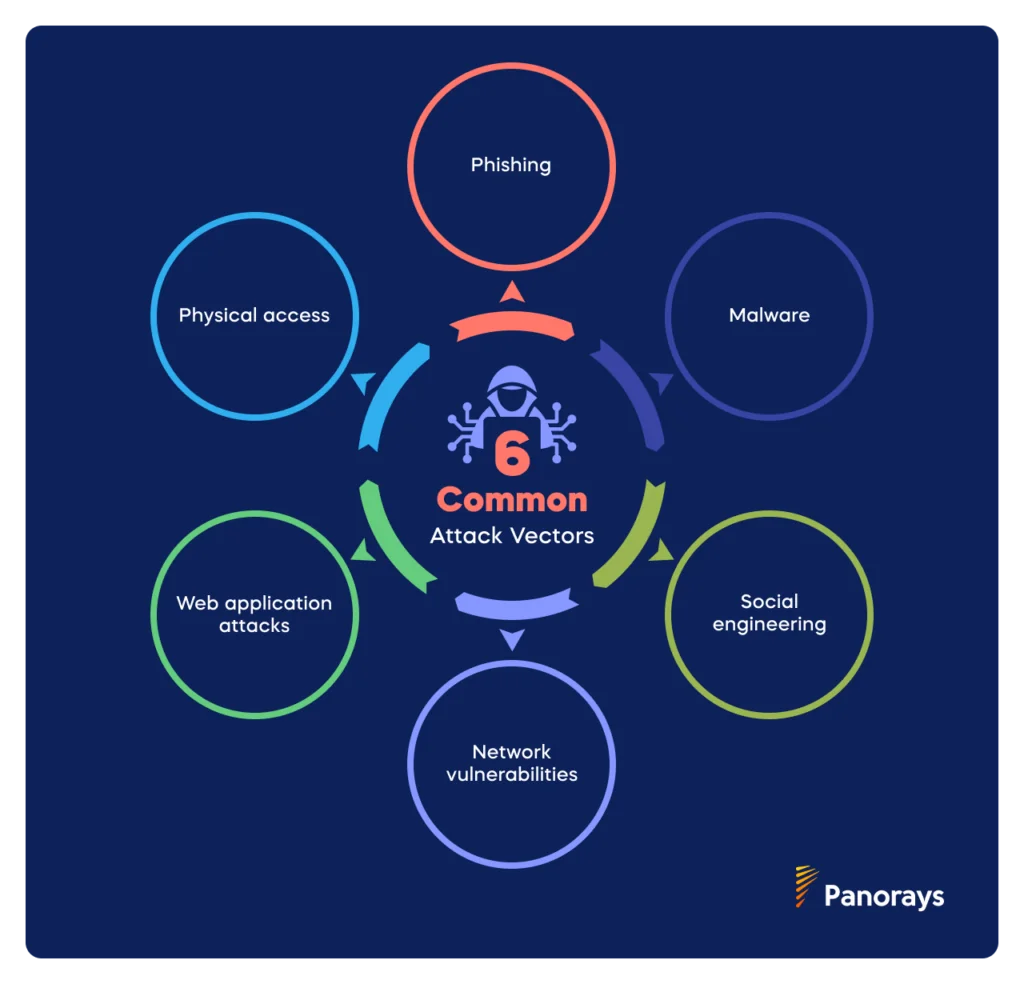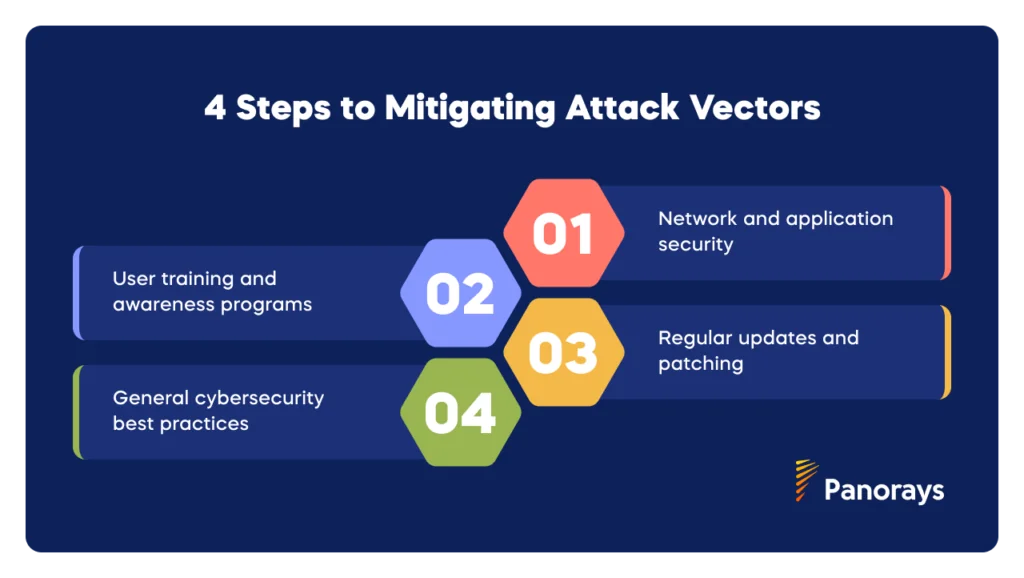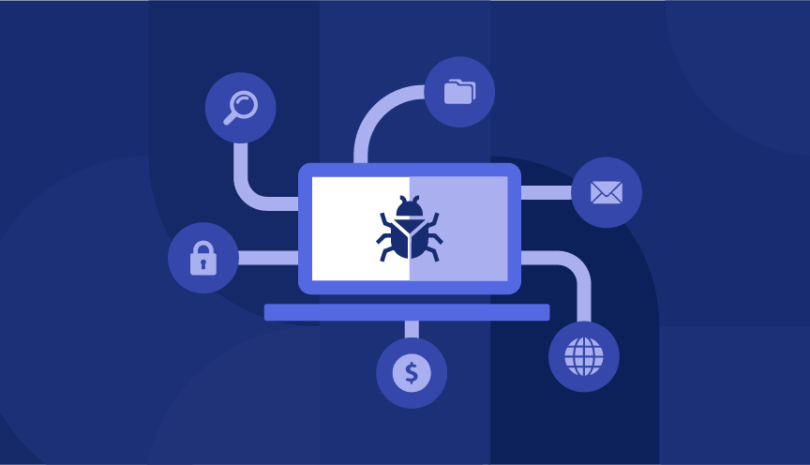To anyone concerned with cybersecurity, understanding attack vectors is crucial. An attack vector is the path or entry point that an attacker uses to gain unauthorized access to your system, network, or data. Once you define an attack vector, you identify the path or method that a threat actor could use to breach your system’s security. Then you can take action to mitigate the potential security risks.
There are many different attack vectors, including phishing, malware, web application attacks, and even physical access to your server. Malicious actors might use a combination of attack vectors in order to disrupt your business systems, steal data, and/or cause data breaches.
In this article, we’ll explain the main attack vectors and how they work, and share best practices for identifying, assessing, and mitigating attack vectors for your organization.
Attack Vector Trends in 2025
Malicious actors never stop trying to penetrate your systems and breach your sensitive data, so cybersecurity always needs to keep one step ahead. Here are the main attack vector trends that you can expect to see this year, both among attackers and those trying to prevent them.
Rise of Supply Chain Cyberattacks
Malicious actors have quickly realized that extended supply chains offer excellent opportunities for successful cyberattacks. They’re increasingly targeting weak links in convoluted supply chains — often smaller companies with limited cybersecurity resources — then moving laterally to infiltrate the critical systems and sensitive data of larger organizations.
Third-Party API & SaaS Exploitation
Threat actors are focusing on the SaaS supply chain, which is opaque and hard to monitor. Many SaaS platforms that you’ve integrated into your business ecosystem rely on third-party applications, using APIs to enable seamless interactions between all the parties. This introduces more security risks and expands your attack surface.
Increased Ransomware Attacks on Vendors & MSPs
2024 saw more ransomware attacks than any previous year, and 2025 is predicted to be even worse. Attackers use AI to increase the volume and sophistication of attacks, so more are slipping through cybersecurity defenses. Your vendors and MSPs are favorite targets, because attackers know that they can serve as portholes into bigger organizations.
Third-Party Insider Threats on the Rise
Third-party insider threats continue to be among the hardest threats to detect and prevent, and their numbers are set to keep rising in 2025. Companies are still looking for more effective ways to proactively manage insider threats, so attacks will continue to slip past their defenses.
Deepfake & AI-Powered Social Engineering Attacks
As AI grows more effective and more accessible, malicious actors are using it to power more convincing social engineering attacks. This includes deepfake audio and video that are hard to distinguish from the “real thing,” and leveraging sensitive data to personalize social engineering attacks.
Growing Threats from Open-Source & Third-Party Code Vulnerabilities
Increasing risks accompany the rising adoption of open-source code. According to the WEF, open-source code makes up at least 70% of any given software package. Threat actors are infiltrating OSS libraries to inject malicious code, which they can easily exploit to access your critical systems or sensitive data.
Third-Party Cloud Misconfigurations & Shadow IT Risks
SaaS solutions make it easy for employees to grant unverified tools access to sensitive data and critical systems, creating a growing fleet of shadow IT. Meanwhile, the rise of the cloud means that mistakes in configurations can have serious consequences. These will be significant attack vectors in the coming year.
AI-Based Risk Assessments for Third-Party Vendors
As attack vectors rise and the threat posed by third-party vendors increases, cybersecurity teams are turning to AI for help. AI-powered risk assessments deliver improved visibility into complex supply chains and enable proactive third-party risk management, helping reduce the attack surface.
Regulatory Pressure & Third-Party Cybersecurity Compliance
Another angle that cybersecurity teams will use to reduce attack vectors is that of third-party regulatory compliance. Ensuring that vendors adhere to relevant regulations is already an important element in risk management, but as threats rise, it becomes more important to enforce compliance to cybersecurity standards.
Continuous Third-Party Risk Monitoring & Zero Trust Integration
Given that third-party cybersecurity compliance is set to increase this year, you can expect a rise in enforcement methods. Continuous monitoring is crucial for verifying that third parties meet their cybersecurity and compliance requirements, while zero trust integrations remove any trust-by-default arrangements to prevent unauthorized access.
What is the Difference Between an Attack Vector, Attack Surface, and a Threat Vector?
Cybersecurity teams need to pay attention to at least three overlapping concepts: attack vectors, attack surface, and threat vectors. They all refer to ways that attackers could gain entry to your systems, but there are important differences between them.
- An attack vector is a specific method or pathway that’s used by attackers to achieve unauthorized access to your systems, networks, or data.
- An attack surface refers to all the potential entry points that an attacker could use to exploit vulnerabilities. The larger your attack surface, the more entry points and attack vectors it will have.
- A threat vector is broader than an attack vector. It refers to the various ways that threats could exploit vulnerabilities in your system, including multiple attack vectors as well as other elements that contribute to your risk landscape.
Common Types of Attack Vectors

There are several different types of attack vectors. Any robust cyber security program needs to consider and address each one of them. Malicious actors sometimes combine various vectors to carry out a complex attack, or they might try different attack vectors consecutively to see which will be the most effective.
The main types of attack vectors include phishing and social engineering attacks, malware, attacks that exploit network vulnerabilities or weaknesses in web applications, and even physical attacks.
In the next few sections, we’ll explain the different types of attack vector in more detail, together with insights into the ways that attackers use these different vectors.
Attack Vector: Phishing
Phishing attacks are a type of social engineering attack using email, text messages, or phone calls. In a phishing attack, malicious actors pretend to be a trusted entity, like a security team member from a local bank or an employee in one of your third parties. They try to trick the victim into sharing sensitive information, like their password or login credentials.
Usually, phishing attacks exploit human fear and anxiety to pressure them into making poor decisions under stress. For example, in 2022 many Netflix subscribers received a phishing email that claimed that their subscription was about to expire and urged them to renew it immediately.
Attack Vector: Malware
Malware, short for malicious software, is a catch-all term for different types of programs designed to infiltrate, damage, or exploit systems and data.
It can include:
- Viruses, which attach themselves to legitimate files and spread
- Trojans, disguised as legitimate software
- Ransomware, which encrypts your data and demands payment to return it
- Worms which replicate and spread across networks
- Spyware which secretly monitors user activity to steal passwords and credentials
What makes malware so insidious is that it can be delivered and executed through multiple methods, including phishing emails with malicious attachments or links, downloads from compromised websites, or infected USB drives.
Attack Vector: Social Engineering
Social engineering attacks involve manipulating people into leaking confidential information or compromising their organization’s security. Unlike phishing, social engineering attacks are personalized to carefully target a specific individual.
For example, an attacker could pretend to be an IT support member asking for login credentials, or a colleague who needs urgent help to access sensitive data.
A social engineering attack can use various tactics to exploit human trust, curiosity, or fear, including pretexting, where attackers create a fabricated scenario to obtain information, and baiting, where victims are offered something appealing in exchange for sensitive details.
Attack Vector: Network Vulnerabilities
Network vulnerabilities include any weakness within your network infrastructure that attackers could exploit.
Common network vulnerabilities include:
- Unpatched systems with outdated software that has known security flaws
- Open ports which aren’t properly secured
- Weak or default passwords that can be easily guessed
- Misconfigured devices, applications, or systems that permit unauthorized access
Attackers exploit these vulnerabilities using a range of techniques. For example, they might use port scanning to spot open ports, or brute-force attacks to crack weak passwords. Once malicious actors gain access to your network, they can move laterally to attack any area, disrupt critical business operations, or breach sensitive data.
Attack Vector: Web Application Attacks
Web application attacks are an attack vector that specifically targets web-based applications. Attackers take advantage of poor coding practices, insecure input validation, or unpatched vulnerabilities, sometimes using automated tools to scan for weaknesses.
Like network vulnerabilities, web application attacks can take many forms. In SQL injection attacks, attackers inject malicious SQL code into a query to manipulate the database. Cross-site scripting (XSS) attacks involve injecting malicious JavaScript code into web pages or web apps.
Through these injections, attackers can impersonate legitimate users and utilize their credentials to gain unauthorized access.
Attack Vector: Physical Access
As an attack vector, this involves gaining physical access to an organization’s servers, devices, data centers, or other hardware. Attackers might force their way into secured areas by tampering with physical controls like locks, following an employee who has authorized access, or stealing someone’s authorization badge, key, or code.
A physical attack could completely override your digital cybersecurity protections, allowing the attacker access to your most sensitive systems, infrastructure, and data. Once an attacker has gained physical access, they could steal data, install malware, destroy assets, and more.
How Attack Vectors Exploit Security Weaknesses
So far, we’ve discussed what attack vectors are. Now we’ll address the methods used to exploit these vectors and carry out an attack.
Most attack vectors begin by identifying an entry point, such as an email, website, physical device, or open port, which gives them initial access to the system or network. Then they look for more vulnerabilities, like unpatched software, weak passwords, or poor security configurations, so they can escalate control over the system.
Once they’ve gained access to your ecosystem, they compromise it by actions like stealing data, installing malware, and/or disrupting business operations. The success of any attack vector depends on their ability to bypass defenses and exploit weaknesses.
How Attack Vectors Use Entry Points
As you’d guess from the name, an entry point is a weak spot that serves as the initial pathway for any attack vector. There are numerous types of entry points, depending on the vector.
- Email is a common entry point for phishing and social engineering attacks, and to send malware through an infected attachment or web link.
- Websites are popular entry points for malware and web application attacks. Simply visiting a compromised site can trigger the automatic download of malicious software.
- Physical devices are entry points for a physical attack vector, and to introduce malware directly into the system through an infected USB drive.
Vulnerability Exploitation Methods
Attack vectors exploit vulnerabilities by targeting weaknesses in systems or applications to gain unauthorized access and compromise systems. They might exploit a number of vulnerabilities at once to achieve success.
The most common techniques used by attackers to exploit vulnerabilities include:
- Brute-force attacks to crack weak passwords
- Man-in-the-middle attacks to intercept and manipulate communications between parties
- Zero-day exploits that target vulnerabilities that haven’t been made public and don’t yet have a patch
- DDoS attacks to crash your systems by overloading them with network traffic
- Exploiting software flaws such as buffer overflows or SQL injection vulnerabilities
How Attack Vectors Can Impact Systems
Once an attacker successfully breaches your security through one or more attack vectors, they can control your critical systems or data, steal sensitive information, install malware, or manipulate system functions.
This could have disastrous consequences, ranging from financial losses from theft or fraud to reputational damage due to publicized breaches, penalties for failing to protect data, and operational downtime that loses you revenue. The compromise of sensitive data could even lead to identity theft, loss of intellectual property, or be used to drive more attacks on other individuals or organizations.
Identifying and Assessing Attack Vectors
It’s crucial to mitigate attack vectors as much as possible. The first step is to identify all your attack vectors and assess the level of risk that each one poses. This gives you the information you need to find the best ways to close up and reduce attack vectors.
Identifying and assessing attack vectors is a multi-step process. You’ll need to:
- Conduct a vulnerability assessment to map and reveal vulnerabilities in your system
- Maintain threat intelligence into potential threats and emerging attack vectors
- Carry out risk assessments to evaluate the potential risks associated with different attack vectors and prioritize security efforts where they are most needed
Vulnerability Assessment
A vulnerability assessment is the process of identifying and assessing existing attack vectors that threaten your organizational security, using a range of tools and methods to uncover vulnerabilities.
Unless your system is extremely small, you’ll need automated vulnerability scanners that reveal known weaknesses like outdated software or misconfigurations in your systems and applications. Otherwise, it’s easy to miss something that leaves a window open into your systems.
Other methods for identifying vulnerabilities include penetration testing by security professionals that simulates attacks to find and exploit vulnerabilities, and manual code reviews and security audits to uncover logic flaws or complex configuration issues
Threat Intelligence
Threat intelligence involves gathering and analyzing information about potential threats and attack vectors. By leveraging threat intelligence, you can keep ahead of emerging attack techniques used by cybercriminals, such as new malware strains or phishing schemes. This way, you can anticipate and prepare for specific attack vectors.
To gather threat intelligence, you’ll need a number of sources and methods, including feeds from threat intelligence tools, vulnerability databases, and cybersecurity reports that provide insights into recent attacks. Organizations should share information about attacks and threats, so that everyone is better prepared.
Risk Assessment
Risk assessments allow you to assess the likelihood and impact of various attack vectors and prioritize those that are most serious. This way, you can allocate your resources more effectively and target your security measures to the most serious threats.
To evaluate the potential risks of each attack vector, you’ll need to assess the severity of vulnerabilities, the damage an attack could cause, and the likelihood of exploitation. Then you can rank vulnerabilities in order of priority. Start by addressing high-impact vulnerabilities which could lead to significant data breaches or operational disruptions.
Attack Vector Mitigation Strategies

Now you’re ready to mitigate the attack vectors you’ve identified. You’ll need a range of strategies that encompass numerous proactive measures. Together, these strategies form a comprehensive approach to mitigating attack vectors and enhancing your security posture.
Key components include:
- Network and application security such as firewalls, intrusion detection systems, and secure coding practices
- User training and awareness programs to educate employees on recognizing and avoiding common attack methods
- Regular updates and patching to keep systems and software up-to-date and close security gaps that attackers might exploit
- General cybersecurity best practices, such as strong password policies and access controls
Attack Vector Cybersecurity Best Practices
General cybersecurity best practices do a great deal to reduce exposure to attack vectors and strengthen defenses against them. These include:
- Enforcing strong password policies and login credentials, including changing all default login settings
- Applying multi-factor authentication (MFA) as an additional layer of protection
- Employing network separation so that the most sensitive areas of your network have separate controls
- Implementing least privilege access controls to limit user permissions to what is strictly necessary
- Regular security audits and vulnerability assessments to spot and mitigate weaknesses before they can be exploited
- Monitoring your third parties for vulnerabilities that could serve as a back door to your systems
Regular Updates and Patching Fix Attack Vectors
Software developers release patches and updates to fix known security flaws, which means that malicious actors probably already know these vulnerabilities exist. But an astonishing number of organizations don’t keep on top of software updates and patches, leaving gaping gaps in their security.
Keeping your devices, systems, and applications up-to-date and patched is the simplest and most effective way to prevent anyone from exploiting security weaknesses as an entry point to your systems. This includes your antivirus software and your firewalls.
User Training and Awareness Help Reduce Attack Vectors
Employees are the weakest link in any cybersecurity plan, so it’s vital to educate yours about attack vectors. Train your users to recognize and report common attack methods like phishing, social engineering, and malware.
Training sessions can educate employees about how to spot suspicious emails, avoid clicking on untrusted links, and verify the identity of individuals requesting sensitive information. It’s best to use simulation platforms and run awareness campaigns to reinforce these lessons. This way, you’ll foster a culture of vigilance, and strengthen your overall defenses.
Network and Application Security Stops Attack Vectors
Multiple layers of network and application security tools and protections can limit attack vectors and frustrate attempts to infiltrate your systems. These include:
- Firewalls that act as a barrier between internal networks and external threats, filtering traffic to block unauthorized access and malicious data
- Intrusion detection systems (IDS) that monitor network traffic for suspicious activities, and alert administrators to potential security breaches
- Secure coding practices for applications, including validating input, sanitizing data, and reviewing code for flaws, to prevent vulnerabilities like SQL injection or XSS attacks
How Incident Response and Management Reduce Attack Vectors
Robust attack vector detection and response strategies help reduce the risk of future attacks by closing attack vectors and strengthening overall security. Continuous monitoring for signs of malicious activity gives you an early warning so that you can limit attack vectors and minimize the impact of any attack.
The faster and more effective your response, the better you can contain the threat and prevent any further exploitation of unauthorized access to your systems or data. Finally, analyzing every attack helps you to understand how it occurred, and identify previously overlooked weaknesses that you need to resolve.
Attack Vector Detection and Response
Security teams need a range of tools and techniques to detect attacks that aim to exploit specific vectors. These include intrusion detection systems (IDS) and security information and event management (SIEM) platforms, which monitor network traffic, log data, and system activities for anomalies. They can spot the signs of specific attack vectors, such as unusual login attempts, unexpected file changes, or spikes in network traffic.
Together with this, they need a robust response strategy that is activated automatically when an attack is detected. This would involve containing the threat by isolating affected systems, eradicating the malicious activity, and restoring normal operations as quickly as possible. By quickly detecting and responding to attack vectors, organizations can minimize damage, protect sensitive data, and prevent attackers from exploiting other vulnerabilities.
Post-Incident Analysis
Examining an attack enables security teams to see which attack vectors were exploited, and what to change to reduce the likelihood of similar attacks in the future and build a more resilient security framework. Post-incident analysis should include a detailed review of how attackers bypassed existing security measures, which vulnerabilities were exploited, and what specific tactics, techniques, and procedures (TTPs) were used.
By reconstructing the incident, security teams can identify weaknesses in their defenses, such as gaps in detection capabilities or flaws in response protocols. You might decide to improve user training, ramp up threat intelligence, strengthen your security controls, and/or invest in better monitoring tools.
Secure Your Attack Vectors
A thorough understanding of your attack vectors is crucial for any robust cybersecurity program. You need to know which attack vectors pose the highest risk and understand the methods that attackers use to exploit them, before you can apply mitigation strategies and harden your security posture.
It’s important to include your third parties as an integral element of any attack vector assessment and mitigation policy. The best way to monitor them for vulnerabilities or weaknesses that could serve as entry points for attackers is to use Panorays. It’s the only third-party risk management platform that continuously maps all your third parties and assesses their risk in the form of a dynamic Risk DNA score.
Using Panorays gives you visibility into changes in your third parties’ security profile, so you can evaluate the level of risk from attack vectors, adapt security requirements, and tweak your own cybersecurity policies and defenses to prevent your organization from damage through attack vectors.
Ready to minimize attack vectors? Get a demo of our third party risk management platform today.


